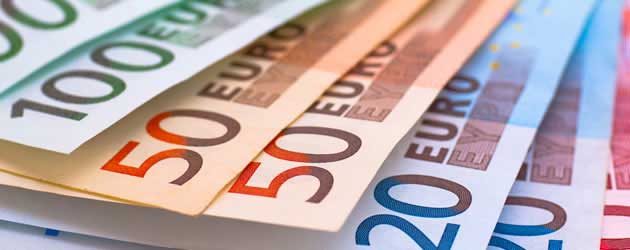 Friday has seen an extension of the problems for the Euro which surfaced after the European Central Bank introduced a fresh stimulus package and cut all of its rates. The Pound, whilst weak against nearly all of its competitors, has continued to trend high against the single currency.
Friday has seen an extension of the problems for the Euro which surfaced after the European Central Bank introduced a fresh stimulus package and cut all of its rates. The Pound, whilst weak against nearly all of its competitors, has continued to trend high against the single currency.
The GBP to EUR exchange rate is currently trending in the region of 1.2594.
In a surprising effort to avoid low inflation having an impact on the Eurozones weak economy; the European Central Bank cut all of its rates by 10 basis points on Thursday and opted to introduce a fresh stimulus package. The immediate aftermath saw the Euro plummet across the board.
European Central Bank President Mario Draghi outlined a number of issues that forced the ECB into action; ‘In August, we see a worsening of the medium-term inflation outlook, a downward movement in all indicators of inflation expectations […] Most, if not all, the data we got in August on GDP and inflation showed that the recovery was losing momentum’.
Despite having made gains against the Euro; the Pound has been generally sluggish versus the majority of its major peers. This can be attributed to several factors; but principally to the increasing trader anxieties surrounding the Scottish bid for independence.
Since a YouGov poll showed that the lead for the pro-unionists had diminished from 22% to just 6% in under a month; trader sentiment towards the Pound has waned considerably. With the voting deadline fast approaching the debate between the unionists and nationalists is still throwing up more questions than it does answers.
Sterling weakness can also be attributed to a succession of disappointing Eurozone domestic data publications over the past month or so.
The Pound Sterling to Euro exchange rate has hit a low on Friday of 1.2585.
Friday has seen little difference in the Pound to Euro exchange rate despite some better-than-forecast European economic data publications. Year-on-year German Industrial Production was forecast to show a 0.6% increase, having shown a deficit of -0.4% previously, but the actual data showed an impressive growth of 2.5%.
Eurozone data was also upbeat having met with the forecast figures. The year-on-year Eurozone Gross Domestic Product equalled the 0.7% forecast, and the quarter-on-quarter GDP hit the flat line figure forecast.
Friday’s British economic data is not quite as desirable although it has made little impact on the Pound to Euro exchange rate. The Bank of England published their inflation forecast for the next 12 months which has risen to 2.8% from 2.6%. Given that the Bank of England’s inflation target is at 2% the increase in the forecast doesn’t spell good news; especially if future labour market data miscorrelates.
The Pound Sterling to Euro exchange rate has hit a high on Friday of 1.2622.
Forecast for the Pound to Euro Exchange Rate
Monday September 8th
There are several European domestic data publications due on Monday, but only one of which holds any weighting in terms of wider market movement. German Trade Balance is one of the biggest components of Germany’s Balance of Payment and hit 16.5 billion in June. German Labour Costs, Current Account, Exports, Imports, and the Eurozone Investor Confidence may be of interest to see whether the recent ECB stimulus has had any impact.
The solitary British data publication on Monday will be of little significance to wider market movement but will be of interest to those invested in Sterling. The Lloyds Employment Confidence hit 6 in July.
Tuesday September 9th
Tuesday’s single European economic data publication, the German Fourth Quarter Manpower Employment Outlook, is unlikely to spark much movement with its low weighting economically.
In contrast there are several British economic data publications on Tuesday of varying significance. Chief amongst these will be the NEISR Gross Domestic Product Estimate for August, which hit 0.6% previously.
The UK Visible Trade Balance, Trade Balance Non EU, Total Trade Balance, Industrial Production and Manufacturing Production will also have the potential to spark movement for Sterling.
Wednesday September 10th
With an absence of economic data pertaining to either the UK or Europe on Wednesday the exchange rate is likely to be dictated by foreign currency movement and geopolitical changes.
Thursday September 11th
There will be only one British economic data publication on Thursday in the form of the RICS House Price Balance, although this is unlikely to have a dramatic effect on Sterling movement.
In terms of European domestic data the German Consumer Price Index and the German Consumer Price Index – EU Harmonised have the potential to ignite changes for the single currency. Thursday will also see the ECB publish its monthly report which will be of interest considering the recent changes in ECB monetary policy.
Friday September 12th
Friday’s British economic data, Construction Output, will be fairly insignificant in terms of the provocation of Sterling movement, but may be of interest economically.
European data will be of greater significance. Eurozone Industrial Production and Eurozone Employment will be of interest; both economically and to gauge whether the ECB stimulus package has had any impact at this early stage.

